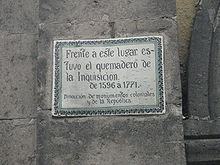Tribunal of the Holy Office of the Inquisition in New Spain | |
|---|---|
| History | |
| Established | 4 November 1571 |
| Disbanded | 10 June 1820 |
| Leadership | |
First Inquisitor | |
Last Inquisitor | Manuel de Flores |
| Meeting place | |
 | |
| Palace of the Inquisition, Mexico City | |
| Footnotes | |
| See also: Spanish Inquisition Peruvian Inquisition | |


The Mexican Inquisition was an extension of the Spanish Inquisition into New Spain. The Spanish conquest of the Aztec Empire was not only a political event for the Spanish, but a religious event as well. In the early 16th century, the Reformation, the Counter-Reformation, and the Inquisition were in full force in most of Europe. The Catholic Monarchs of Castile and Aragon had just conquered the last Muslim stronghold in the Iberian Peninsula, the kingdom of Granada, giving them special status within the Catholic realm, including great liberties in the conversion of the native peoples of Mesoamerica. When the Inquisition was brought to the New World, it was employed for many of the same reasons and against the same social groups as suffered in Europe itself, minus the Indigenous to a large extent. Almost all of the events associated with the official establishment of the Palace of the Inquisition occurred in Mexico City, where the Holy Office had its own major building (which is now the Museum of Medicine of UNAM on República de Brasil street). The official period of the Inquisition lasted from 1571 to 1820, with an unknown number of individuals prosecuted.[1][2]
Although records are incomplete, one historian estimates that about 50 people were executed by the Mexican Inquisition.[3] Included in that total are 29 people executed as "Judaizers" between 1571 and 1700 (out of 324 people prosecuted) for practicing Judaism.[4]
- ^ Hamnett, Brian R. (1999). Concise History of Mexico. Port Chester NY USA: Cambridge Univ. Press. pp. 63–95. ISBN 978-0-521-58120-2.
- ^ Jose Rogelio Alvarez, ed. (2000). "Inquisicion". Enciclopedia de Mexico (in Spanish). Vol. VII (2000 ed.). Mexico City: Sabeca International Investment Corp. ISBN 1-56409-034-5.
- ^ Jose Rogelio Alvarez, ed. "Inquisicion" (in Spanish). Enciclopedia de Mexico. VII (2000 ed.). Mexico City: Sabeca International Investment Corp.. ISBN 1-56409-034-5
- ^ Chuchiak IV, John F. The Inquisition in New Spain, 1571-1820: A Documentary History Baltimore:Johns Hopkins University Press, 2012, p. 236